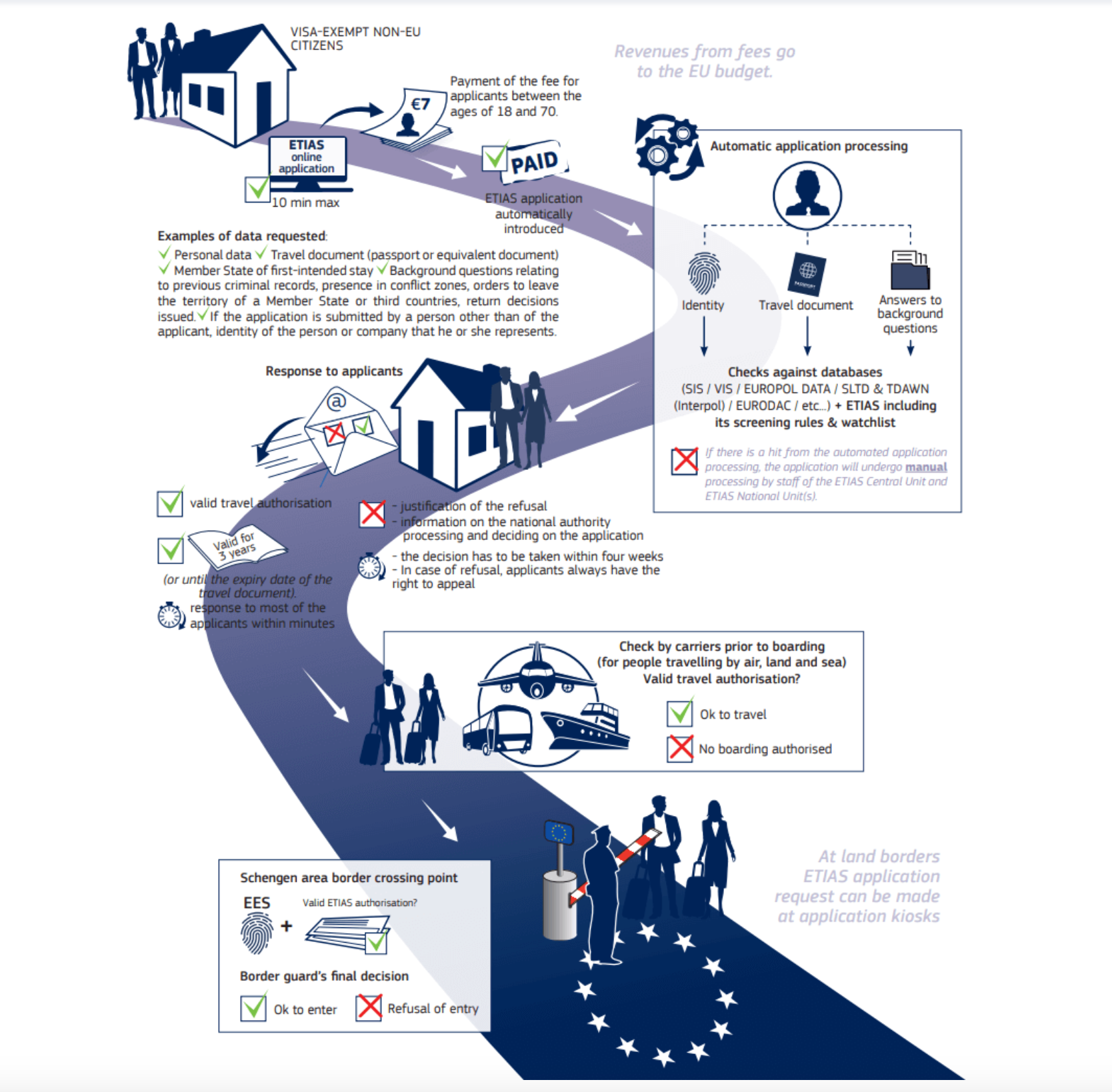Some significant changes are coming to the visa-free travel to Europe that most Americans have become accustomed to enjoying. Come 2024, Americans will be required to apply for a visa and pay a small fee to visit Europe.
The coming European Travel Information and Authorisation System is set to launch sometime in 2024, though that date has been pushed back many times (and could be pushed again). In fact, the region has talked about instituting the program since 2016.
The new program will require travelers from countries outside the Schengen Area of Europe to fill out an application before arrival and pay a fee to visit France, Spain or any other country in the European Union or Schengen Area. That’s going to add another layer of bureaucracy when the program rolls out.
Wondering what this means for future trips to Europe? Here’s everything you need to know about the new visa program.
What is ETIAS?

For now, Americans don’t need a visa to visit Europe. That is about to change.
ETIAS is a visa-waiver scheme similar to the current Electronic System for Travel Authorization used in the U.S. for visitors from Europe.
The form will act as a preauthorization system to allow travelers from 63 countries outside the Schengen Area, including the United Kingdom and the U.S., to enter the region for up to 90 days within a 180-day period without a full visa. It’s also good for multiple entries for up to three years. You won’t need to apply for approval each time you travel to Europe unless it’s been more than three years since your last visit.
It’s not a traditional visa because it only requires a seemingly quick online application. You’ll fill out an online form with basic personal information and your travel plans and history; you’ll also answer a few security questions. The authorities promise that most applicants will be approved within an hour; however, if your application is flagged, it could take up to four days.
The application will cost about $8, but those over 70 or under 18 won’t have to pay a fee. It will also be required for all travelers, no matter how young.
ETIAS will cross-check visitor information with government databases and watchlists before issuing authorization to enter. The information collected will also be used in data tracking for business and tourism purposes.
Why is the region rolling this program out?
“We need to know who is crossing our borders,” former European Commission president Jean-Claude Juncker said. “This way, we will know who is traveling to Europe before they even get here.”
Which countries will require an ETIAS?
There are quite a few nations that are included in the ETIAS requirements. They include full Schengen members that previously didn’t require any kind of visa for Americans, such as Spain, France and Italy. They also include nations in the European Free Trade Association, such as Iceland, Norway and Switzerland. Several future Schengen member nations, including Bulgaria and Cyprus, and a few small territories like Andorra and Monaco will require an ETIAS as well.
Here is the full list of counties that will require ETIAS:
- Andorra
- Austria
- Belgium
- Bulgaria
- Czech Republic
- Cyprus
- Denmark
- Estonia
- Finland
- France
- Germany
- Greece
- Hungary
- Iceland
- Italy
- Latvia
- Liechtenstein
- Lithuania
- Luxembourg
- Malta
- Monaco
- The Netherlands
- Norway
- Poland
- Portugal
- Slovakia
- Slovenia
- Spain
- Sweden
- Switzerland
How much will ETIAS cost, and what information will you have to provide?
The ETIAS will cost 7 euros (about $8) for a three-year permit that allows “third-country nationals” to enter the Schengen Area for up to 90 days within a 180-day period. Only visitors between the ages of 18 and 70 will need to pay the application fee, but those of all ages will still need ETIAS authorization to enter.
Travelers will be asked to provide details of health, education and criminal convictions.
Here is what you’ll be required to fill out, according to Schengenvisainfo.com:
- Biometric information, including your first name, last name, last name at birth, date of birth and place of birth
- Information regarding your citizenship
- Address
- Email and phone number
- Education and work experience
- First EU country you intend to visit
- Background and eligibility questions about your medical condition, travel to war countries or places where you were deported or rejected, as well as criminal records
- For minors, the legal guardian must apply for ETIAS
- For family members of EU citizens from other countries, you must submit proof of relationship, residence card and other background information
Who needs to apply for ETIAS?
American citizens (and those from the 62 other non-EU countries that are not currently required to apply for visas) will need ETIAS authorization to enter the EU for visits of up to 90 days; this includes transit passengers.
If you have applied separately for a visa to enter Europe, you will not need to complete the ETIAS application.
When and where will ETIAS go into effect?
The launch of this long-planned system has been pushed several times over the years, but it sounds like it could finally happen in 2024.
At that point, airlines, cruise ships and other transport systems will be required to check for ETIAS authorization before allowing passenger boarding; visitors will be required to complete the application process prior to travel. At land borders, visitors should be able to complete the application at an electronic kiosk.
How do you apply for ETIAS?

Before traveling, you’ll need to access the ETIAS online application to input passport information, name, date and place of birth, email address, phone number and a credit or debit card to submit the payment fee. You’ll also need to provide your destination and answer a few background and profile questions. The ETIAS website indicates the form should take about 10 minutes to complete.
Approval for most applicants should take a matter of minutes. However, if an item is flagged in the application, a manual review must occur. The applicant can correct the improper information or appeal a denial decision.
How will your personal data be stored?
The European Commission has attempted to soften privacy fears by insisting that the ETIAS is not a visa and therefore includes a far less intrusive application process.
“There is no need to go to a consulate to make an application, no biometric data is collected and significantly less information is gathered than during a visa application procedure,” the European Commission said.
Bottom line
Fortunately, Brits and Americans planning to visit Europe don’t need to take any immediate action. However, be prepared to go through one more step and pay one more fee in the travel process as part of the ETIAS implementation sometime in 2024. Stay tuned to TPG for further developments related to this program.
Related reading:
- When is the best time to book flights for the cheapest airfare?
- The best airline credit cards
- What exactly are airline miles, anyway?
- 6 real-life strategies you can use when your flight is canceled or delayed
- Maximize your airfare: The best credit cards for booking flights
- The best credit cards to reach elite status
Additional reporting by Matt Blake and Bill Fink.




